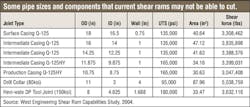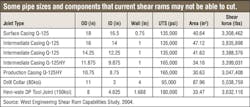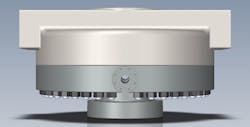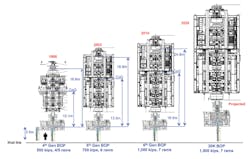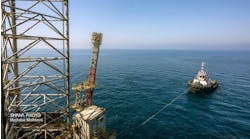Jay Read
BOP Technologies
Roy Shilling
Frontier Deepwater Solutions LLC
The Presidential Commission that studied theDeepwater Horizon tragedy called a BOP the “last line of defense” to prevent a catastrophic release of hydrocarbons into the environment. However, when it comes to this critical barrier that protects the rig and its crew, the industry is still using 90-year-old technology that has simply increased in size, weight, and complexity over time.
Originally, BOPs had only pipe rams, which were designed to close and seal around drill pipe. When the industry moved offshore and subsea wells were developed, the same closing technology behind the pipe ram was adapted to shear rams. As designed, it would cut the drill pipe when needed and allow a floating drilling unit to safely perform an emergency disconnect while still shutting in the well. Over the years, shear ram BOPs have increased in size and actuation pressure in order to generate more and more force to cut the ever-larger and stronger tubulars run in the wellbore. The net result in today’s post-Macondo world is that BOPs may need to be twice the size and weight of those used just a little more than a decade ago. Even with this dramatic increase in size and capacity, they are still not able to generate the force required to cut all of the tubulars that are currently being run into the wellbore. In other words, during significant periods of time, drilling and subsea completions of wells are taking place when there is an unshearable tubular in the path of the shear rams.
FollowingDeepwater Horizon, the industry committed to prevent such a tragedy from ever happening again. The problem is that the ability to prevent a blowout still depends on a 90-year old design that these authors feel has reached its design limits. Post-Macondo, the new BOPs still produce less than 2.5 million pounds of shearing force, but they require very large dual hydraulic actuators along with a large number of accumulator bottles to deliver the 5,000 psi operating pressure at depth. Since these BOPs still cannot reliably shear large tool joints on drill pipe, an additional shear ram is now required so that at least one of the shear rams will not cut through the drill pipe body, rather than through the tool joint.
Limitations in force
As mentioned earlier, shearing BOPs are based on the design that James Abercrombie and Harry Cameron patented in 1922. They have gotten more powerful and complex, but the fundamental engineering principal has not changed much. They can now shear and seal on most drill pipe, but cannot cut Hevi-Wate tool joints, drill collars, or some thick walled casing strings.
Recent studies indicate that these “unshearables” may be across the BOP more than 10% of the time, which is an unacceptable level of risk.
This limitation contributed to one of the largest oil spills in history, when, in 1979, PEMEX’s IXTOC I in Campeche Bay experienced a blowout. The shear rams were activated at a time when they happened to be lined up with a drill collar, so they failed to cut and arrest the leak. The IXTOC I oil spill took nine months to control.
TheDeepwater Horizon blowout also raised questions whether conventional shearing BOPs have the power to successfully shear and seal the well.
In this case, the upward flow of hydrocarbons buckled the drillstring, pushing it to the side of the BOP and moving it out of the direct path of the shearing zone of the rams. There were a number of other complications that limited the effectiveness of the shear rams, but investigators questioned whether existing shear rams could generate the force required to completely close and seal a well when the pipe is off-center.
The resulting blowout took nearly three months to get under control and cap the well.
Size and weight
Adding an additional shear ram to in an effort to ensure that at least one ram is not lined up on a tool joint increases both the height and weight of the BOP. Increasing the shear force requires implementing ever-larger actuating pistons with even higher operating pressures. The larger actuators and heavier accumulator bottles also increase the size and weight of the BOP stacks. Next-generation BOP stacks which are capable of working in 20,000 psi environments will be more severely impacted. Also, BOP stacks that are larger are more difficult to transport and lower into position. They may require significant rig modifications to fit within its moonpool, testing, and handling system. Significantly, they can impart more fatigue loading into the wellhead and may be too heavy to support in the event of a weak point failure during a drive off or drift off event. This raises the very real danger of a blowout that will rage unchecked until a relief well can be drilled.
BOP Technologies believes that the current shear ram designs have met their limitations. For this reason, it is taking a different approach with its Circular Intensifier Ram Blowout Preventer (CIRBOP). Intensifying the pressure within CIRBOP allows it to deliver 5 million pounds of shearing power to the ram, which is enough to shear anything in the wellbore.
The centralized design allows for a mechanism with a smaller diameter, which measures about 12 ft (3.6 m) across, versus 19 ft (5.7 m for current designs). Additionally, the new system requires less hydraulic fluid, and has a limited number of components, which is designed to make the technology more reliable, less expensive, and easier to maintain.
The design that debuted in the 1920s has served the industry well for a long time, but these authors believe it is time to move on to the next generation BOP, as we face the new challenges of oil and gas exploration.
